Exploring Popular Pet Birds in Australia


Intro
Care Tips
Taking proper care of pet birds is essential for their health and happiness. Ensuring that your avian companion thrives involves several key aspects of daily habits and environments.
Daily Care Routines
Regular attention and interaction are vital to your bird's well-being. Engage in activities such as:
- Daily feeding of fresh vegetables and birdseed.
- Offering clean water at all times.
- Spending quality time, optimal for their social nature.
Cage Setup and Maintenance
A suitable cage is crucial for your bird’s comfort. Consider the following:
- Size: Ensure the cage is spacious enough for movement.
- Bar spacing: Bars should be close enough to prevent escape.
- Accessories: Include perches, toys, and dishes for food and water.
Regular maintenance is also necessary. Clean the cage weekly to remove waste, ensuring a hygienic environment.
Hygiene and Cleaning Practices
Birds can be sensitive to dirt and bacteria. Implement these cleaning tips:
- Disinfect food and water containers regularly.
- Use bird-safe cleaning products.
- Clean perches and toys frequently.
Seasonal Care Adjustments
Weather changes can affect birds uniquely.
- In summer, provide ample fresh water and shade.
- In winter, ensure they are kept warm with appropriate bedding.
Behavioral Insights
Understanding a bird's behavior is crucial for creating a positive environment. Each species has its unique personality traits.
Understanding Bird Body Language
Birds communicate through body language. Learn to observe:
- Fluffed feathers may indicate a relaxed or sleepy state.
- Rapid wing flapping can signal excitement or distress.
Common Behavioral Issues and Solutions
Behavioral challenges may arise. Some common issues include:
- Excessive squawking, which might require more stimulation or interaction.
- Feather plucking, often linked to stress or boredom.
- Solutions might include increased playtime or environmental enrichment.
Positive Reinforcement Techniques
Using rewards can help modify behavior. Encourage good habits by:
- Offering treats when they perform desired actions.
- Using praise when they display calm behavior.
Social Interaction Needs
Birds are social creatures. Regular interaction is essential. They thrive on companionship, whether through human contact or fellow avian friends.
Nutrition Guides
Proper nutrition is fundamental to a bird's health. Feeding strategies can vary based on species.
Essential Diet Components
An ideal diet usually consists of:
- Pellets formulated for specific species.
- Fresh fruits and vegetables.
Safe and Toxic Foods
Be mindful of what you offer. Common safe foods include apples and carrots. Toxic foods include:
- Avocado
- Chocolate
Supplements and Treats
In addition to a balanced diet, include:
- Occasional seeds as treats.
- Calcium supplements, especially for breeding species.
Feeding Strategies for Different Species
Each species has distinct needs. Research your bird's specific dietary requirements to ensure optimal health.
Wellness and Health
Regular health monitoring can prevent issues down the road.
Routine Health Checkups
Schedule veterinary visits annually to check for:
- Weight fluctuations
- Feather condition
Identifying Symptoms of Illness
Be alert for signs such as:
- Changes in eating habits
- Lethargy in activity
Preventative Care and Vaccinations
Discuss vaccination options and preventive care measures with your veterinarian to keep your bird in top shape.
Mental and Emotional Well-being
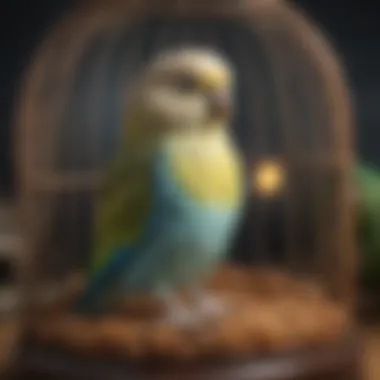
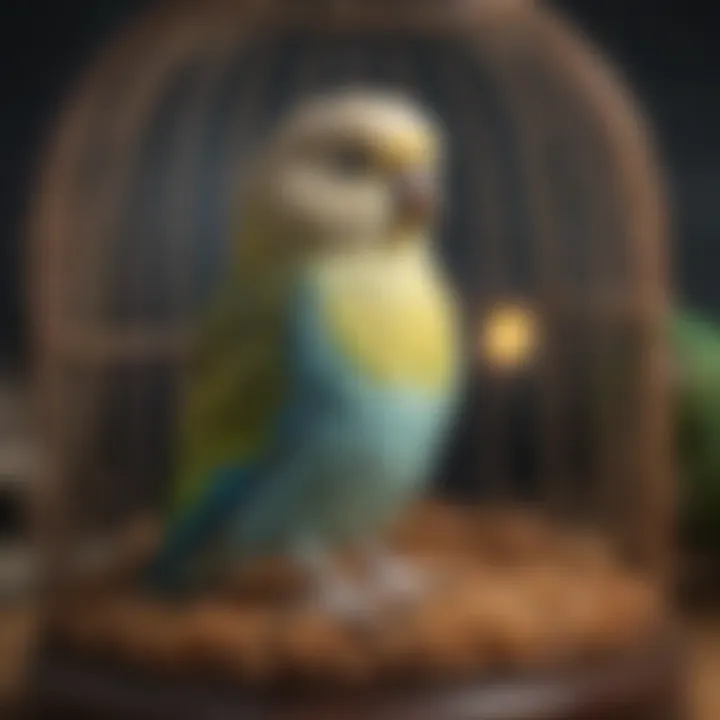
Birds require mental stimulation. This can include:
- Interactive toys
- Regular playtime outside their cage
Enriching Activities
To ensure a happy and healthy bird, create a stimulating environment.
Toys and Playtime Ideas
Select toys that encourage natural behavior like chewing or climbing. Rotate toys to maintain interest.
Training and Tricks
Teaching them simple tricks can be rewarding. Start with basic commands, rewarding them for success.
Outdoor Activities and Interaction
Supervised outdoor time can help them enjoy natural sights and sounds. Be cautious of predators and environmental hazards.
DIY Projects for Mental Stimulation
Consider crafting toys or puzzles from safe materials, fostering curiosity and engagement.
Maintaining the well-being of pet birds involves understanding their nature, providing appropriate care, and ensuring a stimulating environment. This comprehensive approach can lead to a fulfilling companionship.
Prelude to Pet Birds in Australia
Australia has a rich diversity of wildlife, and its avian species are no exception. Pet birds in Australia are more than just companions; they embody cultural values, joy, and responsibility. Understanding the significance of these birds can enhance the experience of pet ownership, leading to better-informed decisions regarding care and compatibility. This section serves to illuminate the multifaceted realm of pet birds in Australia, setting the stage for deeper explorations of specific species and their needs.
Cultural Significance of Birds
Birds have long been integral to Australian culture. They symbolize freedom and connection to nature. Many communities celebrate the presence of native species, and this reverence has translated into a strong interest in keeping birds as pets. In Indigenous cultures, birds often hold spiritual significance, representing stories and traditions passed down through generations. This cultural appreciation enriches the relationship between humans and birds in domestic settings. Pet ownership can foster empathy and understanding of conservation, as many bird owners become advocates for their habitats.
"Understanding the cultural backgrounds related to avian life can create a more profound respect and commitment to their well-being."
Trends in Bird Ownership
In recent years, bird ownership has seen a marked rise among Australians. Various factors drive this trend, including an increasing awareness of mental health benefits linked to pet ownership. Birds provide companionship, reduce stress, and can even boost one's mood. Additionally, the accessibility of information on bird care has made it easier for potential owners to make informed decisions.
Social media platforms like Facebook and Reddit have transformed the way bird enthusiasts connect and share knowledge. These platforms allow for a vibrant community where experiences and tips are exchanged. The trend also reflects a broader movement toward valuing pets that foster interaction without requiring excessive space or specific conditions, making birds a suitable choice for various living situations.
In summary, understanding the importance of pet birds in Australia involves examining their cultural relevance and the growing trend of bird ownership. This foundation enables readers to navigate complex topics like species care and companionship with better insight.
Finches: Diverse and Colorful Companions
Common Species of Finches in Australia
Australia is home to several species of finches, each with its unique traits. Some of the most common include:
- Zebra Finch: Known for their distinctive black and white stripes, Zebra Finches are charming and easy to care for. They are vocal and often display interesting behaviors.
- Society Finch: This species has a soft appearance and is known for its friendly demeanor. Society Finches are social birds, making them great companions for other finches.
- Gouldian Finch: Renowned for their breathtaking colors, Gouldian Finches require a bit more care but are regarded as a stunning addition to any aviary.
These species are just a few examples, but they represent the diversity available to potential bird owners. Choosing the right finch can depend on personal preference and care capabilities.
Care Requirements for Finches
Caring for finches involves several key elements, primarily concerning habitat setup, nutritional needs, and social interaction.
Habitat Setup
A proper habitat setup is crucial for the wellbeing of finches. They thrive in spacious environments that allow for flight and exploration. Key characteristics of an appropriate setup include:
- Cage Size: A larger cage is recommended. Generally, a minimum size of 24" x 18" x 18" is suitable for a small group of finches. This size allows them to fly and exercise adequately.
- Perches: Various perches should be included. Different materials and thicknesses will help keep their feet healthy.
The unique feature of a well-set habitat is its ability to mimic their natural surroundings. It enhances the finches’ quality of life, encouraging their natural behaviors, such as flying and hopping. Inadequate living conditions can lead to stress and health issues.
Nutritional Needs
Finches require a balanced diet to ensure they remain healthy. The primary components include:
- Seeds and Pellets: High-quality seed mixes specifically formulated for finches are important. Pellets can also provide nutritional completeness.
- Fresh Foods: Vegetables and fruits should be offered regularly. Options like spinach, carrots, and apples provide essential vitamins.
The essential characteristic of their diet is its diversity, which contributes to their overall health. A varied diet reduces the risk of nutritional deficiencies but requires careful monitoring to ensure they are not overfed and maintain a healthy weight.
Social Interaction
Socialization is vital to the health of finches. They are inherently social creatures that thrive in groups. Important aspects include:
- Pairing Up: It is strongly advised to house finches in pairs or small groups. They often become anxious or depressed if kept alone.
- Interactive Time: Regular human interaction can help them become comfortable and less skittish around their owners.
A big advantage of fostering social interaction is that it encourages natural behaviors, such as chirping and preening. However, keeping too many birds together in a small space can lead to territorial disputes or stress. It's essential to balance the environment well.
"A thriving finch community not only enhances the beauty of your home but also promotes the health and happiness of each individual bird."
In summary, understanding finches as companions presents a rewarding experience for pet owners. Their care, while straightforward, needs attention to detail and commitment to ensure both individual and social well-being.
Cockatiels: Charming Personalities
Cockatiels are among the most cherished pet birds in Australia, known for their engaging behavior and affectionate nature. Their unique personalities make them an excellent choice for both new and experienced bird owners. As a species, they exhibit traits that not only endear them to their owners but also contribute to the dynamic of any household. Understanding these characteristics is crucial for anyone considering a cockatiel as a companion.
Characteristics of Cockatiels
Cockatiels are medium-sized parrots, typically featuring a distinctive crest and bright plumage that is often enhanced by vibrant shades of yellow, gray, and orange. Their physical appearance is complemented by an amiable demeanor, making them particularly approachable.
In terms of personality, cockatiels are known for their playful and social behavior. They thrive on interaction, often displaying a range of vocalizations that range from soft whistles to more complex sounds. This ability to mimic certain noises adds to their charm, enriching the social experience for their owners. They adapt well to different environments, making them suitable pets for various living situations, whether in apartments or larger homes.
Training Cockatiels
Training is an essential aspect of owning a cockatiel. It fosters a strong bond between the bird and its owner while also ensuring that the cockatiel is well-behaved and socialized.
Basic Commands
Teaching basic commands to a cockatiel establishes a foundation for communication. It involves simple cues that the bird can learn over time. Common commands include standing, stepping up, and coming when called.
This training is particularly beneficial as it not only encourages a responsive behavior in the bird but also helps in managing situations where the bird might feel threatened. The key characteristic of these commands is their simplicity; they are easy for both the owner and the cockatiel to understand. A unique feature is the reward system often employed, which reinforces good behavior and makes training more effective. However, patience is necessary, as not all birds will respond at the same rate.
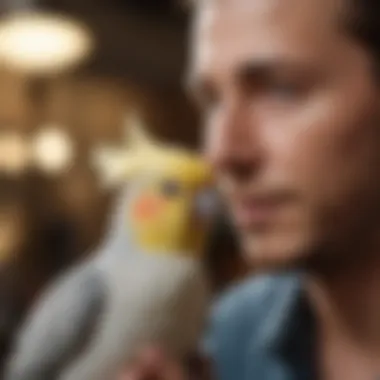
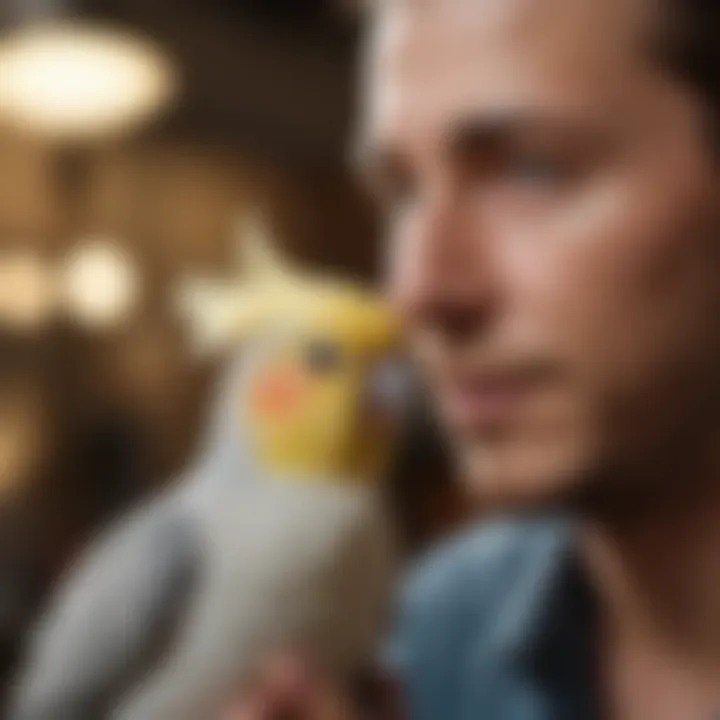
Socialization Techniques
Socializing cockatiels is equally important. This process involves exposing the bird to different environments, sounds, and people. A well-socialized cockatiel tends to be more confident and less fearful. The essential aspect of socialization lies in regular interaction with the bird, creating a comfortable setting.
The main advantage of effective socialization techniques is that they promote friendly and affectionate behavior in cockatiels. They can develop a trusting relationship with their owner, as well as a sense of security in their environment. One potential disadvantage could be the time requirement, as consistent social exposure is necessary for optimal results.
Behavioral Enrichment
Behavioral enrichment is crucial for stimulating a cockatiel’s mind and preventing boredom. It involves providing an array of activities that promote exploration and play. This may include toys, foraging opportunities, and even interaction with other birds.
The main feature of behavioral enrichment is its capacity to mimic natural behaviors found in the wild, which contributes to the overall well-being of the bird. Enrichment is a beneficial approach since it enables cockatiels to engage in instinctual activities, resulting in happier, healthier birds. However, it requires ongoing effort; owners must constantly update or rotate toys and activities to maintain interest.
"Training and socialization form the backbone of a successful relationship with cockatiels, enriching their lives and yours."
In summary, understanding the characteristics of cockatiels, coupled with proper training and socialization techniques, lays the groundwork for a rewarding ownership experience. By focusing on these areas, owners can nurture their cockatiels into well-adjusted companions.
Parrots: Intelligent and Social Birds
Parrots are considered some of the most intelligent and social pet birds. Their vibrant personalities and strong social bonds make them a popular choice among bird lovers in Australia. Understanding these characteristics is essential for anyone considering bringing a parrot into their home. They not only require appropriate care but also thrive in environments that stimulate their social instincts. This section breaks down key aspects of popular parrot species and their methods of communication, which are both fundamental to their well-being.
Popular Parrot Species
When it comes to selecting a parrot, potential owners should be aware of the various species available, each with unique traits and needs. Some popular species in Australia include:
- Budgerigar: Often known as budgies, they are small, colorful, and sociable. They adapt well to home life and are relatively easy to care for.
- Cockatoo: These larger birds are known for their playful nature and emotional attachment to owners. They require significant interaction and mental stimulation.
- African Grey Parrot: Highly intelligent and excellent mimics, African Greys demand a lot of attention and mental challenges.
- Amazon Parrot: Known for their social nature, they are energetic and can be quite loud, requiring spacious environments to thrive.
Each species has its own unique requirements and compatibility factors, which must be considered for a harmonious relationship.
Companionship and Communication
Understanding how parrots communicate is crucial for their care and integration into a household. Their vocalizations and body language offer insights into their feelings and needs.
Vocalizations and Mimicry
Vocalizations and mimicry are standout features of a parrot's personality. These birds have the remarkable ability to learn and replicate sounds, including human speech. This characteristic not only entertains but also strengthens the bond between the parrot and its owner.
While mimicry is fascinating, it is essential to note that excessive loudness can be a challenge. Owners may find that some birds may develop a preference for certain sounds or phrases. Providing a stable environment and consistent interaction can help manage this behavior. Mimicry also has its downsides, as it might lead to misunderstandings in bird-owner communication if not appropriately guided.
Understanding Body Language
Understanding body language in parrots is as important as interpreting their vocalizations. Parrots use their physical stance, feather positions, and movements to express feelings. For instance, a parrot that is excited may puff its feathers and hop, indicating readiness for play or interaction.
Recognizing these cues can significantly enhance the relationship between the bird and its owner. However, some behaviors can be misread, leading to stress for the bird. Creating a relaxed environment where they can express themselves freely enhances their well-being. Learning to interpret these signals is an ongoing process that fosters communication and insight into the bird’s emotional state.
Communication through vocalizations and body language is essential in fostering a strong bond between parrots and their owners.
Lovebirds: Affectionate and Playful
Lovebirds are renowned for their playful nature and strong social bonds. As small parrots native to Africa, these birds have gained popularity in Australia as pets. Their charming personality and vibrant colors make them appealing companions. Understanding their behavior, needs, and breeds is crucial for potential owners. Choosing lovebirds can enrich life through affection and companionship, providing owners with joyful interactions.
Overview of Lovebird Breeds
There are several lovebird breeds that potential owners can consider. These include the Peach-faced lovebird, Fischer's lovebird, and Masked lovebird, among others. Each species has unique characteristics, colors, and personalities. Here’s a brief overview of some popular breeds:
- Peach-faced Lovebird: Known for its striking peach-colored face, this breed is playful and curious. It can be quite vocal and loves interacting with owners.
- Fischer's Lovebird: With vibrant green fur, this breed tends to be smaller. They are social and enjoy being in pairs or groups.
- Masked Lovebird: Characterized by their black mask, these lovebirds are affectionate and enjoy playtime. They bond well with their owners.
Each breed offers something unique, which appeals to different bird owners’ preferences.
Creating a Stimulating Environment
A stimulating environment is essential for lovebirds to thrive. They need mental and physical engagement, which directly affects their happiness and health. Building an engaging space encourages natural behaviors and reduces stress. A well-structured setting will include various activities and social opportunities for the birds.
Social Play and Interactions
Social play is a key characteristic of lovebirds. It involves interacting with one another, engaging in playful activities, and forming strong bonds. Lovebirds enjoy each other's company and benefit from having a companion. This social aspect reduces loneliness, making them feel secure.
Having multiple lovebirds is often a popular choice. They engage in mutual grooming and play, enhancing their well-being. Moreover, they often mimic each other's behaviors, fostering a deeper connection.
One unique feature of social play is its capacity to promote emotional stability. Birds that engage socially often show fewer signs of stress. However, one should be mindful of individual personalities, as some lovebirds may require gradual introductions.
Activities to Encourage Bonding
Engaging activities facilitate bonding between lovebirds and their owners. Providing toys, perches, and interactive games is essential for building trust. Lovebirds respond positively to activities that involve their owners, fostering closer relationships.
One key characteristic of bonding activities is their adaptability. Owners can create an enriching experience tailored to their lovebird's preferences. For instance, puzzles can stimulate their minds while physical activities promote fitness and play.
A unique feature of bonding activities is their potential to enhance behavior. Lovebirds that participate in activities with their owners tend to display fewer disruptive behaviors. Therefore, consistent interaction is vital for developing a harmonious relationship.
"Creating a positive environment supports the overall well-being of lovebirds, making them happier pets."
Aviary Setup: Home for Your Feathered Friends
Creating a suitable aviary for pet birds is crucial for their health and happiness. An effective aviary provides a safe, stimulating, and comfortable environment. It not only allows birds to exercise but also encourages natural behaviors like flying and socializing. With proper planning, owners can set up an aviary that meets the needs of their feathered companions and enhances their well-being.
Key Considerations for Aviaries
When designing an aviary, consider the size, location, and materials used. The aviary should have sufficient space to allow birds to fly and interact freely. A larger aviary will also accommodate more birds without causing stress. The location should be protected from harsh weather, direct sunlight, and potential predators.
Additionally, using non-toxic and durable materials is essential for longevity and safety. Ventilation is another significant element. Good airflow helps to minimize moisture and unpleasant odors, contributing to a healthier living space.
Essential Accessories for Your Aviary
Perches and Toys
Perches and toys are vital for any aviary. They provide birds with places to rest and engage in play. Selecting perches of various diameters and textures is important for foot health. Birds naturally prefer different types of surfaces under their feet, which prevents boredom and encourages exercise.
In addition to traditional wooden perches, consider natural branches as a fun option. Toys stimulate mental and physical activity, preventing destructive behaviors. Chewable toys are particularly effective in keeping birds occupied and mentally engaged.
Feeding Stations
Feeding stations play a significant role in your birds' diet and health. They should be conveniently located to minimize stress during feeding times. Choose feeders that prevent spillage and contamination, as birds are vulnerable to bacteria. Additionally, consider using multiple stations to accommodate several birds without competition.
This setup encourages a social environment during feeding, fostering companionship among aviary residents. It is crucial to clean feeding stations regularly to maintain hygiene and prevent illness.
Grooming Areas
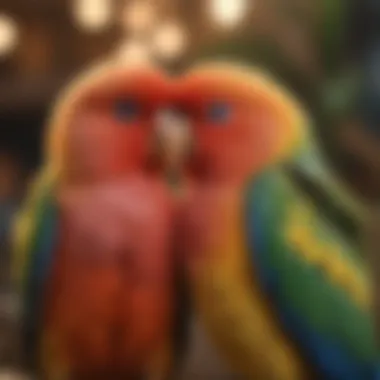
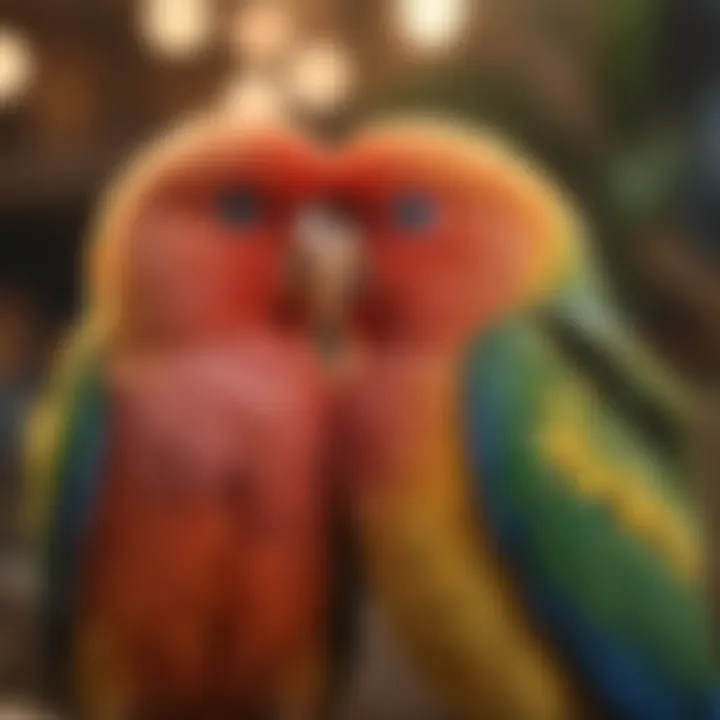
Grooming areas are often overlooked but are essential for maintaining the birds' health and hygiene. These spaces should allow birds to bathe and preen comfortably. Incorporating shallow water dishes or bird baths will encourage birds to engage in natural grooming behaviors, helping to keep their feathers in good condition.
A well-designed grooming area can prevent the accumulation of dirt, feathers, and other debris. This contributes to a healthier environment and lessens the risk of illnesses associated with poor hygiene.
Remember: Regularly assess and adjust the aviary setup as needed to meet the changing needs of your birds. This flexibility will enhance their overall quality of life.
Nutrition: Feeding Your Avian Companions
Nutrition plays a critical role in the health and wellbeing of pet birds. A balanced diet is not just about filling the food bowl. It involves understanding the unique dietary needs based on species, age, and health status. Proper nutrition influences the bird's energy levels, feather quality, and longevity. Owners should approach feeding not just as a task, but as an opportunity to enhance their bird's quality of life.
Daily, pet birds require a variety of food types to meet their nutritional requirements. These can include seeds, pellets, fruits, and vegetables. The right mix can prevent dietary deficiencies and related health problems. It takes a bit of effort to provide this balanced diet, but the benefits far outweigh any inconvenience. A well-fed bird is often more active, vocal, and less likely to develop health issues.
Understanding Avian Diets
Birds in the wild consume a diverse array of foods. Each species has its natural preferences and requirements. For example, some birds are seed eaters while others may thrive on fruits or flowers. Mimicking this natural diet is essential for pet birds to maintain good health.
Understanding the specific dietary needs of different species can provide insights into how to best feed them. For instance, things like protein sources, essential vitamins, and minerals are crucial. Chicken or fish can be important for larger birds, while smaller ones may require different nutritional approaches altogether.
It is advisable to consult with a vet or avian nutritionist for recommendations tailored to your bird. This helps to prevent any unintentional harm caused by improper feeding. Also, it’s important to observe how your bird reacts to different types of food. Some might show a preference for certain items, which can guide you in making better choices for their diet.
Seeds, Pellets, and Fresh Foods
When it comes to basic diets for pet birds, you will find three primary categories: seeds, pellets, and fresh foods.
- Seeds: While seeds are often seen as the staple food for many species, they alone do not provide a complete diet. Seeds can be high in fat and low in essential vitamins. Thus, they should only serve as a part of a balanced diet.
- Pellets: Commercially prepared pellets are designed to meet the nutritional needs of birds. They provide a good alternative to seeds as they are often fortified with vitamins and minerals. Choosing high-quality pellets is key, as cheaper options might lack essential nutrients.
- Fresh Foods: Fresh fruits and vegetables should be included in the diet as well. They provide moisture and additional vitamins. Items like apples, carrots, and leafy greens can be offered regularly, ensuring they are safe for your specific type of bird. Introducing new foods gradually is wise, as it allows your bird to adjust and helps gauge their reaction to different flavors and textures.
Important: Always avoid harmful foods like avocado, caffeine, and chocolate, as they pose health risks to birds.
Health and Wellness: Ensuring Longevity
The health and wellness of pet birds are paramount for their overall quality of life and longevity. Understanding the specific health needs of different bird species can lead to better care and, consequently, happier pets. When birds are healthy, they exhibit lively behaviors, are more sociable, and have a vibrant appearance. Neglecting health can decrease a bird's lifespan and result in various illnesses.
Proper health management includes routine monitoring, timely veterinary care, and a balanced diet. It is essential for bird owners to recognize signs of distress and take proactive steps to address them. A commitment to ensuring the well-being of pet birds not only enriches their lives but also deepens the bond between the bird and its owner.
"A healthy bird is a happy bird. Regular care and attention can make a significant difference in your pet's life."
Common Health Issues in Pet Birds
Pet birds, like all animals, are susceptible to a range of health issues. Some of the most frequent ailments include:
- Respiratory infections: These are often caused by environmental factors such as dust, mold, or poor ventilation. Birds are particularly sensitive to air quality.
- Feather plucking: This may be a sign of stress, boredom, or a medical issue. It is crucial to observe any changes in behavior.
- Obesity: Many pet birds are prone to obesity if their diet is not carefully managed. This can lead to serious health issues, including heart problems.
- Beak and nail overgrowth: Inadequate chewing opportunities or lack of proper perches can lead to overgrown beaks and nails, impacting a bird's ability to eat and move around comfortably.
- Gastrointestinal disorders: These may stem from improper diet or environmental stressors.
Bird owners should regularly check for signs of these common issues and administer appropriate care promptly.
Preventive Care and Vet Visits
Preventive care is a cornerstone of avian health management. Regular veterinary visits are essential for ensuring that a bird stays healthy over the years. During these visits, avian veterinarians can provide:
- Routine health checks: These exams can catch early signs of problems, making treatment more effective.
- Vaccinations: Just like other pets, birds may require certain vaccinations to help prevent diseases.
- Nutritional guidance: A vet can guide bird owners on proper dietary practices, helping to prevent obesity and other diet-related illnesses.
- Behavioral advice: Understanding your bird's behaviors is crucial. Vets can offer insights on stress management and enrichment.
Bird owners should schedule check-ups at least once a year, and more frequently for older birds or those showing any signs of health issues. Establishing a solid relationship with a qualified avian vet ensures that your feathered companion has the best chance for a long, healthy life.
Behavioral Insights: Understanding Your Bird
Understanding bird behavior is crucial for pet owners. It allows them to create a harmonious environment that meets the needs of their avian companions. By recognizing and interpreting these behaviors, owners can foster bond and reduce anxiety. This section aims to highlight essential behavioral insights to enhance the overall experience of owning a pet bird.
Interpreting Bird Behavior
Signs of Stress
Signs of stress in pet birds are pivotal for owners to recognize. A stressed bird may exhibit atypical behaviors, such as excessive screeching or plucking feathers. Identifying these signs enables quick action, which is vital to preventing long-term health issues. For instance, when a bird is stressed, it may refuse to eat, leading to further complications.
The ability to read these stress indicators is arguably one of the most beneficial traits for pet owners. The unique feature of stress signals is their variability; different birds express stress in various ways. This can include changes in posture, such as puffing up or hiding. Understanding these aspects helps owners create a more supportive atmosphere for their pets, enhancing their overall wellbeing.
Playful Behaviors
Playful behaviors are essential indicators of a bird's wellbeing. Such behaviors include vocalizations and engaging in active play with toys. These playful actions show that a bird is happy and content, making them appealing to observe. Birds exhibit their playful side through activities like swinging on perches or playing with objects, which not only provides entertainment but also encourages exercise.
A unique characteristic of playful behaviors is their contagious nature. Birds often encourage each other to engage in play, which can promote social bonding. However, it is crucial to ensure that such play is safe and that toys are appropriate to avoid injury. This aspect of observing playful behaviors contributes to the overall health of the bird and enhances the bond owners share with their pets.
Enrichment Strategies
Interactive Toys
Interactive toys serve as an important component in a bird's environment. They stimulate mental engagement and reduce boredom, which is crucial for a healthy pet bird. These toys often encourage problem-solving and physical activity. Owners can offer toys that require manipulation to get treats or toys that make noises when touched.
The significant feature of interactive toys is their ability to prevent behavioral issues caused by boredom. Birds that are not mentally stimulated might develop undesirable habits, such as excessive screeching or biting. Thus, incorporating these toys into the daily routine benefits both the birds and their owners.
Training Games
Training games help reinforce positive behavior while providing mental stimulation. Engaging birds in training sessions can strengthen the bond between owner and pet, promoting trust. These games can range from teaching simple phrases to complex tricks. Regular interaction through training keeps birds alert and interested, further enhancing their wellbeing.
The unique aspect of training games is their customization. Owners can tailor training according to their bird's species or individual preferences. However, patience is vital in this process; some birds may learn faster than others. This element offers a chance for owners to understand their bird's learning pace and allows for a more enjoyable training experience.
Understanding bird behavior significantly enhances the relationship between owners and their feathered companions. By being aware of stress signals and promoting playful interactions, you foster a deeper connection with your pets. This approach ultimately results in healthier, happier birds.
Ending: Selecting the Right Pet Bird
Choosing the right pet bird is a crucial decision for potential bird owners. The final choice influences the overall experience of pet ownership, given the long lifespan of many species, especially considering the varying needs in terms of care and mental stimulation. Understanding the specific requirements of each bird species is essential. It can lead to a more fulfilling relationship between the owner and their feathered companion.
When selecting a pet bird, it is vital to consider its personality and compatibility with your lifestyle. Each bird species has unique traits and social needs. Some birds may require more time and attention, while others might be content with less interaction. Owning a bird is not simply about aesthetics; it involves understanding the responsibilities tied to their care, well-being, and social dynamics.
Additionally, the environmental setup is equally important. The living space must be suitable to ensure the comfort and health of the bird. A proper diet should meet nutritional needs. Ensuring these factors benefits not only the bird but also promotes a harmonious household.
"The bond between a bird and its owner can be profoundly rewarding, but preparation and knowledge are key to making this partnership thrive."
Factors to Consider Before Adopting
Before acquiring a pet bird, several factors should be evaluated to ensure a successful match. Here are some key considerations:
- Time Commitment: Birds need time and social interaction. Consider how much time you can dedicate daily.
- Housing: Ensure you have adequate space for their living environment. Larger birds often need bigger cages and more room to fly.
- Species Characteristics: Research the specific species. Some may be more vocal or territorial than others.
- Allergies: Be mindful of any allergies in your household, as feathers and dander can impact health.
These factors can greatly influence the well-being of both the bird and the owner. Take time to reflect on each aspect before making a commitment.
Building a Healthy Relationship
Establishing a strong bond with your pet bird requires patience and consistency. Here are some essential practices to consider:
- Routine Interaction: Spend daily time talking, playing, and training your bird. This fosters trust.
- Positive Reinforcement: Use treats and praise to encourage good behavior. This method helps your bird learn desired actions effectively.
- Enrichment Activities: Provide toys and puzzles to stimulate your bird's mind. Engaging them in activities promotes mental health.
- Respecting Space: Understand your bird's need for personal space. Allow them to be comfortable and not pressured to engage all the time.
Building a healthy relationship hinges on mutual respect and understanding. As the owner, it is your responsibility to create a nurturing atmosphere where your bird can thrive.















